Top News
July 8, 2011 Ryukyu Shimpo
When talking about the relocation plan that has U.S. Marine Corps Air Station (USMCAS) Futenma moving to Henoko in Nago – something agreed to by both the governments of United States and Japan – Governor of Okinawa Hirokazu Nakaima stated, “I think that the feeling [that it is not possible] is the same in other regions of Okinawa as well.” His comment suggests that the two national governments will not be able to find an alternative relocation site for Futenma Air Station anywhere in the Okinawa prefecture.
We laud the governor’s bold decision to rule out the option of a fallback position of “a relocation site within Okinawa prefecture,” and we request that he devote all his energies to this historic mission of resolving the Futenma issue.
It is crucial that there be an exit strategy that brings about the return of Futenma. Governor Nakaima will visit the United States in September, so before that, we request that he fashions a carefully thought-out strategy to resolve this problem.
We consider that the agreement between the two central governments on the Futenma issue lacks democratic legitimacy. Candidates in the mayoral, gubernatorial, prefectural assembly and national elections whose stated policy was that the functions and facilities for the replacement of the Futenma should move outside the prefecture have consistently won the support of the majority of Okinawan voters. That the people’s will is denied by the decision-making processes of both governments is a malicious abuse of human rights. The Governor should bring this absurdity to the attention of the international community, including the United Nations.
Thirty nine years ago both governments were able to hand over Okinawa from U.S. military administration to the sovereignty of Japan through peaceful negotiations. In comparison with the Okinawa reversion negotiations, it should be possible for both governments to return the 480-hectare Futenma Air Station to the Okinawan people. It is a matter of political leadership. The stabilization of the U.S.-Japan relationship requires the removal of Futenma. We request that the Governor should appeal to all of the members of Congress and the U.S. government. The Okinawa Prefectural Government (OPG) should take advantage of information technology such as e-mail to state its case. The Governor should inform the U.S. government of the criticism from the people of the so-called “sympathy budget allocations” to U.S. bases.
Finding a solution to the Futenma issue is a crucial component of a medium and long-term strategy for eliminating all military bases from Okinawa. After the U.S.-Japan agreement concerning Futenma in 1996, the Ota Masahide OPG administration drew up “the Vision for Okinawa International City Formation” and the “Action Program for the Return of Bases” in its strategy for the future.
In those days, we witnessed changes such as the restructuring of government ministries and agencies, decentralization, deregulation, the Fifth Comprehensive National Development Plan, the Final Report of SACO (Special Action Committee on U.S.-Japan) and regional cooperation within the Asia-Pacific Economic Cooperation Conference.
Okinawa is now in the midst of great upheaval in the context of its outside environment. In Japan, the Democratic Party administration is in stalemate, there is a gradual advance in local sovereignty, there is the earthquake and tsunami related disaster and the Fukushima nuclear accident. There is President Obama’s vision of a nuclear-free world, growing China’s economic and military power, the financial crisis in Japan and the U.S., and the list goes on.
The Okinawa Prefectural Government should identify the changes of the times and play an active role in implementing its desired policy of being rid of bases. For the sake of peace and stability in East Asia it is important that Japan, United States and China enter into a multi-layered dialogue. Governor Nakaima should emphasize the importance of dialogue to the world leaders. This will serve to boost the “Base Free” policy.
We want Nakaima’s visit to the United States this year to be an historic turning point in the road towards the removal of Futenma Air Station. The Governor has made it clear that he will not allow any replacement facilities for Futenma Air Station to be built within the prefecture and so now the people of Okinawa must stand united to achieve the return of Futenma.
(English Translation by T&CT, Mark Ealey)
Go To Japanese
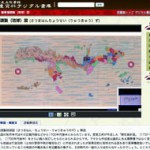
July 3, 2011 Ryukyu Shimpo
In order to make “treasures” of Okinawa more widely known to the public, the Okinawa Prefectural Library has digitalized 610 valuable works from the past such as ancient maps, documents and pictorial diagrams, all of which the library owns, and has started to put them on the Internet. Those works are collected together in a section called the “Digital library for valuable works.”
The library has digitalized these maps and documents with the aim of having them utilized for the study of local history and to help in the compilation and research of the histories of the municipalities of Okinawa, and also to prevent the source materials from becoming worn.
The library is hoping that many people will use the digitalized material, saying, “Anyone can access these valuable works related to Okinawa and utilize them anytime they like, from anywhere. We would like many people to become aware of the charm and depth of Okinawan culture.”
The digital library can be viewed on Okinawa Prefectural Library website.
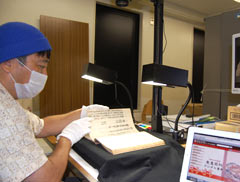
Staff of the Okinawa Prefectural Library are working on digitalizing valuable documents.
Because the digital library can also be viewed using an iPad, the documents, which used to be available only to visitors to the library, can now easily be viewed and utilized.
The library is scheduled to add further 500 documents to the digital library before the end of the year. The library is also working on adding commentaries to the documents in the order that they are put up.
Among the digitalized materials there are valuable works such as an anthology written in 1649 by Nanpobunshi, a monk of the Rinzai sect of Zen Buddhism, who was active from the Azuchi-Momoyama period (1573-1603) through to the Edo period (1603-1867), and Setsudouenyusou, written by Teijunsoku in 1714.
The library has already added commentaries to 40 documents such as the “Shuri ancient map,” “Ryukyu Dyeing” and other materials belonging to the Higashionna Kanjun Zenshu, or Collected Works of Higashionna Kanjun.
Kanjun Higashionna studied Rekidai Hoan (Precious Documents of Successive Generations), an official compilation of diplomatic documents of the royal government of the Ryukyu Kingdom. His studies of the Rekidai Hoan are included in his collected works.
Ryoko Miyagi, the head of Materials Management Division of the library, said, “Reading those commentaries will help people to learn how to appreciate the works, thereby stimulating greater interest.” The library plans to further improve its commentaries on the works.
For the official website for “Digital library for valuable works,” access http://archive.library.pref.okinawa.jp/
(English Translation by T&CT, Mark Ealey)
Go To Japanese
July 6, 2011 Ryukyu Shimpo
Defense Minister Toshimi Kitazawa has refused to meet Nago Mayor Susumu Inamine, who wanted to meet Kitazawa to inform him that he would call for both the U.S. and Japanese governments to reverse the decision to relocate the facilities currently located at U.S. Marine Corps Futenma Air Station to Henoko, Nago City. That official stance was reconfirmed at the U.S.-Japan Security Consultative Committee (2+2) held in Washington on June 21.
Kitazawa explained his refusal to meet Inamine by saying that the mayor had refused to meet the Japanese Defense Ministry’s Okinawa Defense Bureau director, who had tried to explain to him the content of the agreement decided at the U.S.-Japan Security Consultative Committee (2+2).
Kitazawa said, “He needs to get a proper grasp of the situation before he makes any sort of proposition to the government. I do not want to meet a mayor who tries to go straight to the top without listening to an explanation of matters from the Director of the Defense Bureau.”
A minister, a vice minister and a ministerial aid of the Ministry of Defense all refused to meet with Inamine, and instead put forward clerical staff to meet him.
Inamine criticized the Ministry of Defense for refusing to meet him, saying, “The Ministry showed no sign of being prepared to listen to the opinion of the local community.”
While Kitazawa has insisted that he would like to improve the level of communication with the local people of Nago City, who oppose the current relocation plan, on every occasion he has refused to meet Nago Mayor Inamine, who has tried to directly express his opposition to the plan.
Kitazawa said, “Although the Director of the Japanese Defense Ministry’s Okinawa Defense Bureau tried to explain to Mr. Inamine the content of the agreement decided upon at the U.S.-Japan Security Consultative Committee (2+2), he would not meet him. Once he has a proper grasp of the situation, I would like Mr. Inamine to express his thoughts and make a proposition to us.”
After requesting the withdrawal of the decision on the Futenma relocation (reconfirmed at the U.S.-Japan Security Consultative Committee), to Secretary General of the Democratic Party of Japan, Katsuya Okada, Inamine talked to reporters, saying, “The Director of the Defense Ministry’s Okinawa Defense Bureau tried to report about the U.S.-Japan Security Consultative Committee in a matter-of-fact manner, but my approach was not like that at all. I do not really feel that the government is trying to deal with the situation seriously.”
(English Translation by T&CT, Mark Ealey)
Go To Japanese
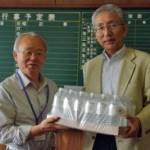
July 4, 2011 Sadao Tome correspondent of Ryukyu Shimpo
Enagic USA, Inc. (President & CEO Hironari Oshiro with its U.S. headquarters in Los Angeles) recently sent bottled water to the areas hit by the Great East Japan Earthquake. Since the earthquake and tsunami, the company has collected donations for earthquake relief from its employees and its distribution outlets across United States. The headquarters heard from its local delivery agent in Tohoku that drinking water is in short supply in the stricken areas.
A bottled mineral water company in California responded to the order by Enagic USA by increasing production to fill a large number of bottles for the emergency relief aid.
Enagic USA shipped 120000 500ml bottles of water (four 40-Foot-Containers) as the first relief aid direct to total six evacuation facilities in the affected areas, including two at Futaba Cho, Iwaki City, Soma City in Fukushima Prefecture, Kesennuma City in Miyagi Prefecture and Otsuchi Cho in Iwate Prefecture.
“We hope that people in the affected areas are able to return to their normal lives as soon as possible,” said a spokesperson for the company.
According to the company, USA Sagawa, Sagawa Global Logistics, the Tokyo Customs Office, the respective prefectural governments and other local organizations cooperated and worked well together, including giving approval as special import as relief aid, so as to facilitate a quick delivery from the United States of a large quantity of bottled water to victims.
(English Translation by T&CT, Mark Ealey)
Go To Japanese
July 2, 2011 Ryukyu Shimpo
On July 1, the first day of the regular meeting of the Okinawa Prefectural Assembly (Chairman Zenshin Takamine), referring to the new Security Research Organization, Governor Hirokazu Nakaima stated, “It will commence no later than next April, but its research activities will be underway this September.” Also with regard to the matter of a field office in the United States for gathering information about military affairs such as U.S. bases in Okinawa and the relocation of Futenma Air Station, he stated, “We want to create something useful on matters related to the base problem. We will appoint resident staff early in the piece, and want to officially launch the field office next April,” when the research office will also be set up.
On the research objectives of both organizations, Nakaima said, “We want to understand the security environment in the Asia-Pacific region. We must be prepared to cope with large-scale natural disasters and need risk management capabilities to prevent the likes of a super-flu from occurring. We must be ready to deal with possible situations in which we ourselves must protect life or property, so not look to just limit ourselves to the narrowly-defined defense issue.”
At the U.S.-Japan Security Consultative Committee (2+2) held on June 21, Japan and United States agreed that a disaster relief hub should be set up in Japan and it is thought that this will be located in Shimoji-jima. On this matter, the governor said, “We must first take a close look at the agreement. Former governors maintained a policy of ‘disapproval of the military use of Shimoji-jima.’ I need to think about how to maintain this policy,” but he declined to go as far as saying that he is clearly opposed to it.
On July 1, the first day of the regular meeting, general questions for the governor and other officials by members of the assembly started.
(English Translation by T&CT, Mark Ealey)
Go To Japanese

July 2, 2011 Ryukyu Shimpo
On July 1, the Ministry of the Environment’s Naha Nature Conservation Office announced numbers confirmed at the end of June for Okinawa rails and Ryukyu long-haired rats killed on the roads.
The number of Okinawa rails killed on the roads amounted to 19, almost equaling the 20 for the same period last year when the Office went as far as declaring a state of emergency for rare species of wild animals in Okinawa such as the Iriomote wildcat, the crested serpent eagle and the Okinawa rail due to the growing number road deaths involving those species.
The number of Ryukyu long-haired rats killed on roads was 14, an increase of four over the same period last year. The trend indicates a faster mortality rate than last year, which recorded 17 at the end of the year, the highest number to date.
The growth period for Okinawa rail chicks is July and August, when there is a high possibility that immature birds, that still lack attentiveness, could find themselves out on the road.
Last July and August nine Okinawa rails were killed on the roads.
Because it mainly lives in trees, the nocturnal Ryukyu long-haired rat moves slowly on roads, increasingly the likelihood of it being hit by cars.
Due to the high incidence of such accidents on roads in the northern area of Okinawa’s main island, the Office calls for drivers to slow down when driving either day or night, especially in the Kunigami area.
(English Translation by T&CT, Mark Ealey)
Go To Japanese
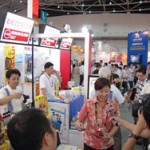
July 1, 2011 Ryukyu Shimpo
Japan External Trade Organization (JETRO) Okinawa and the Okinawa Industry Promotion Public Corporation (OIPPC) reported that, “Okinawan health foods, brown sugar and awamori have been a hit with people at the Taipei International Food Show.” This show was held in Taipei, Taiwan from June 22 to 25. Many companies and food industry organizations from Okinawa participated in the show, carrying out business talks with buyers from leading distribution centers in Taiwan.
JETRO set up a pavilion for companies to exhibit Japanese food and agricultural products in order to expand sales channels in the Taiwanese market. Fifteen companies including manufacturers of processed food and awamori, as well as three organizations, including the Okinawa Prefecture Sake Brewing Federation participated in the show.
An OIPPC representative said, “The local media covered the Okinawan products, and we were able to do some good business. A survey of companies participating found that they expect to see several hundred opportunities appear for business contracts,” and that they look forward to seeing how things develop.
(English Translation by T&CT, Mark Ealey)
Go To Japanese

July 1, 2011 Ryukyu Shimpo
Fifty-two years have passed since June 30, 1959, when a U.S. F-100 fighter from Kadena Air Base crashed into Miyamori Elementary School.
The Association of Children held the 52nd-anniversary memorial ceremony on June 30 at Miyamori Elementary School (principal, Shigemi Iha and 446 pupils) in Uruma City.
The Ishikawa-Miyamori 6-30 Association (president, Mitsuteru Toyohama), which was formed by relatives of the victims of the accident and people concerned with the aim of passing on memories of the crash, also held their first memorial service.
With the rumble of U.S. military planes echoing in the background, the participants prayed for the repose of the souls of the 18 victims, and for lasting peace.
At the memorial ceremony held at Miyamori Elementary School from 8:20am, pupils pressed their hands together as they observed silent prayers while relatives of the victims and local residents looked on.
After offering floral tributes and dedicating one thousand paper cranes to Nakayoshi-Jizo or Good Friend-Jizo (protector of deceased children), which is dedicated to the 18 victims including 11 pupils, the pupils conducted a choral reading for peace and sang Fukugi no ki, a song for peace.
Eleven year-old Kazuma Nakahodo, a sixth-year pupil at Miyamori Elementary School, said, “Even though I have been taking part in the ceremony since I was a first year pupil, I still cannot believe that a U.S. military jet crashed into such a fantastic school. I really think that it is important for us to continue this for the victims’ sake.”
Principal Iha talked to the students, saying, “My heart aches when I think about the pupils who died in the accident. We need to create our own peaceful world and deliver a message for peace from here.”
(English Translation by T&CT, Mark Ealey)
Go To Japanese


July 1, 2011 Ryukyu Shimpo
The little tern (biological name: Sternula albifrons or Sterna albifrons), a migratory bird designated as an endangered species, is now entering the period in which it is cared for by its parents.
At a site on reclaimed land in Naha City, where a flock of about 50 little terns was confirmed, parent birds were seen restlessly feeding their newly hatched chicks. Just three hours since hatching, the chicks are voracious eaters. They enthusiastically accept tiny fish fed to them by their parents.
Until just a few hours earlier, the parent birds had been patiently protecting their eggs in depressions in the sand, enduring the scorching sunlight and the strong winds from a typhoon for about two weeks until the eggs finally hatched.
The parent birds acted menacingly when people approached their nest, jumping around and letting out an aggressive cry.
Little terns fly into several areas of Okinawa, where they breed in colonies on shingle coasts or reclaimed land sites.
The tern’s body length is 30 centimeters. The head of its summer plumage is black, and its beak yellow with a black tip, features which make the little tern unique.
(English Translation by T&CT, Mark Ealey)
Go To Japanese
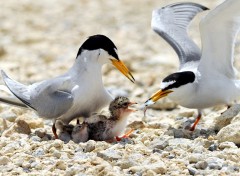
Slideshow of little tern
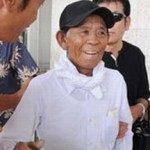
July 1, 2011 compiled from Kyodo News reports
According to the Kyodo News Service, the Kochi office of the Japan Coast Guard stated on June 30 that an Okinawan fisherman and his boat had been found safe off Cape Muroto, Kochi Prefecture, after drifting for 20 days.The captain and his fishing boat had been missing from off the coast of Okinawa since early June.
The fisherman was confirmed as 70 year-old Ryoko Shimabukuro, a resident of Ie Village, Okinawa Prefecture. He is in good physical condition and does not look emaciated. He said, “My fishing boat had been drifting since its engine failed. I was afraid that nobody would find me or the boat.”
According to the Ie Fishermen’s Union, Shimabukuro left Ie Fishing Port to catch sodeika squid on June 8, and was due to return to port around June 18.
Go To Japanese
Ie fisherman Shimabukuro’s happy homecoming after drifting at sea
July 3, 2011 compiled from the report of Ryukyu Shimpo
Seventy year-old captain Ryoko Shimabukuro returned to Okinawa with his brothers on a plane. He was found safe by the Coast Guard, off the coast of Kochi Prefecture after drifting for 20 days on his fishing boat Mitsu Maru, which is owned by the Ie Fishermen’s Union. In response to questions from reporters about his health and how he felt to see his family again, he replied, nodding, “It’s good to see them.” Shimabukuro was hugged by one of his relatives who smiled as he said, “We are happy to see him back safe and sound.”
Around 1:20pm on July 2, Shimabukuro came out through the arrival gate of Naha Airport, wearing a black hat, a white T-shirt and with a towel wrapped around his neck. He walked steadily and only seemed a little tired. He got in to a car with his relatives and departed for Ie-jima.
Go To Japanese
(English Translation by T&CT, Mark Ealey)

June 30, 2011 Ryukyu Shimpo
After passing an examination for food importations, Okinawa Chousei Yakusou Honsha Co., Ltd (President Seikichi Shimoji, Nanjo City) has received approval from the Taiwanese Government to export its products there. The company will commence exports of its products to the Taiwanese market in earnest from this July.
They are aiming at 40 million yen worth of sales in the first year in Taiwan, which follows on from Shanghai in their movement into the international market.
The company started business talks with a Taiwanese trading company at an International Food Fair held there in June 2010, and they entered into a contract last August. From there, the company applied for an examination of its products (the components and raw materials) by the Taiwanese authorities and importation was approved in June.
The company will export its three flagship products, which the main ingredients are turmeric, including Ryukyu-Shugo Densetsu (Hard Drinker’s Legend) and Haru ukontsubu which are both health supplements taken before drinking alcohol, and another supplement Odayaka, which is blended with the gymnema sylvestre herb and guava. In future the company hopes to export other products following on from these three flagship products.
A spokesperson for the company stated, “We hope to lead the way for Okinawan companies in extending the market abroad. We are glad to help expand sales of Okinawan products.”
(English Translation by T&CT, Mark Ealey)
Go To Japanese











 Webcam(Kokusai Street)
Webcam(Kokusai Street)


